
- 192 pages
- English
- ePUB (mobile friendly)
- Available on iOS & Android
eBook - ePub
About this book
Learn how to use and enjoy one of the most satisfying painting mediums with this handy compact guide. Contains essential information on the materials, equipment, and techniques for creating accomplished works in oils. Step-by-step sequences show how to paint a range of themes, from still life to portraits and landscapes, with advice on more difficult subjects. Includes suggestions for presenting your finished paintings and how to go about getting your work seen and exhibited.
Frequently asked questions
Yes, you can cancel anytime from the Subscription tab in your account settings on the Perlego website. Your subscription will stay active until the end of your current billing period. Learn how to cancel your subscription.
At the moment all of our mobile-responsive ePub books are available to download via the app. Most of our PDFs are also available to download and we're working on making the final remaining ones downloadable now. Learn more here.
Perlego offers two plans: Essential and Complete
- Essential is ideal for learners and professionals who enjoy exploring a wide range of subjects. Access the Essential Library with 800,000+ trusted titles and best-sellers across business, personal growth, and the humanities. Includes unlimited reading time and Standard Read Aloud voice.
- Complete: Perfect for advanced learners and researchers needing full, unrestricted access. Unlock 1.4M+ books across hundreds of subjects, including academic and specialized titles. The Complete Plan also includes advanced features like Premium Read Aloud and Research Assistant.
We are an online textbook subscription service, where you can get access to an entire online library for less than the price of a single book per month. With over 1 million books across 1000+ topics, we’ve got you covered! Learn more here.
Look out for the read-aloud symbol on your next book to see if you can listen to it. The read-aloud tool reads text aloud for you, highlighting the text as it is being read. You can pause it, speed it up and slow it down. Learn more here.
Yes! You can use the Perlego app on both iOS or Android devices to read anytime, anywhere — even offline. Perfect for commutes or when you’re on the go.
Please note we cannot support devices running on iOS 13 and Android 7 or earlier. Learn more about using the app.
Please note we cannot support devices running on iOS 13 and Android 7 or earlier. Learn more about using the app.
Yes, you can access Oil Painter's Bible by Marylin Scott in PDF and/or ePUB format, as well as other popular books in Art & Art General. We have over one million books available in our catalogue for you to explore.
Information
Topic
ArtSubtopic
Art General
Fat over lean
Paint which has a high percentage of oil is described as “fat.” “Lean” paint is that which has been thinned with turpentine or mineral spirit only. The golden rule in oil painting is to paint fat over lean, and there are good reasons for this. The drying oils used both in the manufacture of paint and as a medium do not evaporate. They simply dry and harden on exposure to air, but this takes a long time (six months to a year to become completely dry). During this process the paint surface shrinks a little. If lean paint has been applied over oily paint the top layer will dry before the lower one has finished shrinking, and this can cause the hardened lean paint to crack and even flake off.
So, for any painting built up in layers the oil content should progressively increase. The usual practice is to begin with turpentine alone, or turpentine with just a little oil added, and add more oil to the mixture as the painting progresses. The final layer can be as thick as you like, and this is when artists sometimes add highlights in impasto (see page 88).
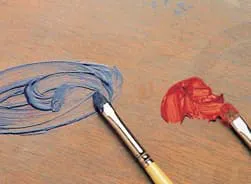
The blue paint on the left is lean, as it has been well diluted with turpentine. The red paint, straight from the tube, has a much more substantial texture.
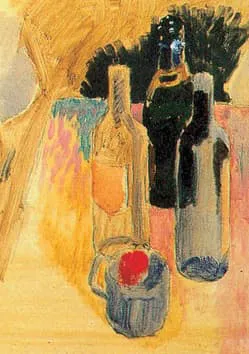
1 Some preliminary underpainting in thin, lean paint provides a basis for the application of subsequent layers of oilier paint.

2 The image is built up using slightly thicker paint, but this is less oily than that which will be used later.
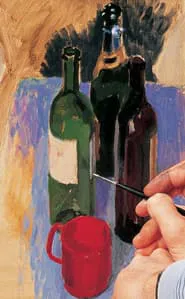
3 Apart from the danger of paint cracking as it dries, another reason for painting fat over lean is that it is difficult to add lean paint to a very oily layer. It does not adhere properly, so your brush tends to lift if off again.
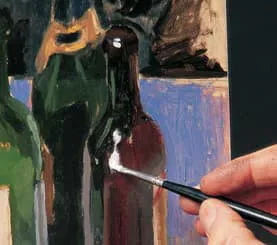
4 Fat white paint straight from the tube is applied for the highlights. This must be done last, as it would be impossible to paint further over these oil-rich patches with the paint still wet.
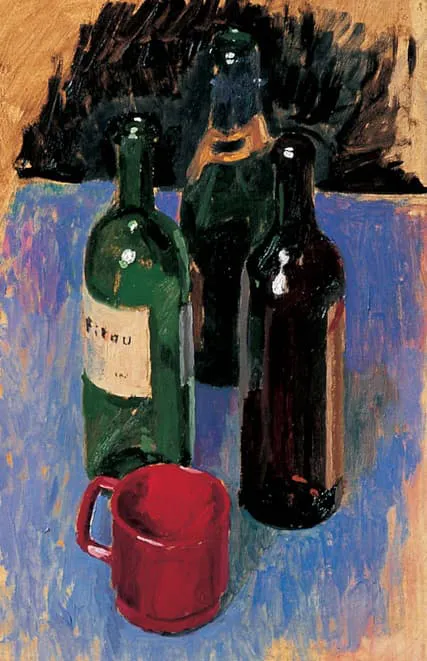
5 The completed painting shows a mixture of different paint thicknesses. The blue tabletop consists of quite lean paint while parts of the bottles have been built up with increasingly oily paint.
Alla prima
This is an Italian term meaning “at first,” and it describes paintings completed in one session. The essential characteristic of this method is that there is no initial underpainting as such (see page 112), although artists will often make a rapid underdrawing in pencil or charcoal to establish the main lines.
After the introduction of tubed paint in the mid-19th century, artists were able to work outdoors more easily. This plein air (open air) painting, as it is called, first undertaken by painters such as Constable, Corot and later the Impressionists, established the rapid and direct approach as an acceptable technique. Hitherto, oil painting had been largely a studio activity, as pigment had to be ground by hand, and paintings were built up slowly in a series of layers.
Working alla prima requires some confidence, as each patch of color is laid down more or less as it will appear in the finished picture. Any modifications and reworking must be kept to a minimum so that the fresh effect is not destroyed.

1 Because it is difficult to get ellipses right, these were first drawn with pencil. The next stage was to block in some of the shaded areas with cobalt blue and the tablecloth with ocher, which helped to establish the feel of the composition. This photograph shows some of the basic colors being laid in with somewhat thicker paint. The colors are those that will appear in the finished painting, though minor modifications can be made as the work progresses.
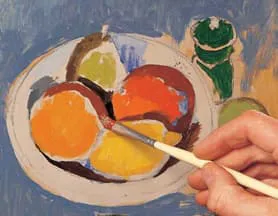
2 The tablecloth has been loosely painted, and now the darker tones of the fruit are developed. The bold brushstrokes give a three-dimensional appearance.

3 The red stripe around the bowl is crucial to the composition, so it is painted next, in a mixture of cad...
Table of contents
- Cover
- Title Page
- Contents
- Introduction
- Materials
- Color
- Techniques
- Subjects
- Index
- Credits
- Copyright